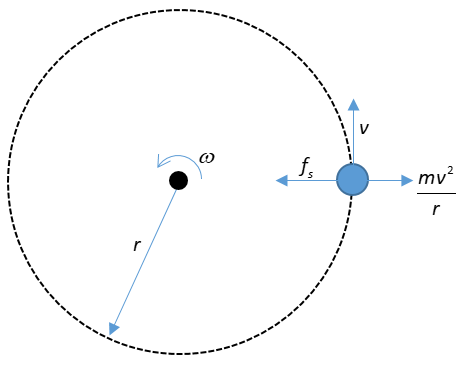
Find the maximum velocity for skidding for a car moved on a circular track of radius 100 m. The coefficient of friction between the road and tyre is 0.2.
A. 0.14 m/s
B. 140 m/s
C. 1.4 m/s
D. 14 m/s
Answer
219.6k+ views
Hint: When the car is moving on a circular track then an outward centrifugal force acts on the body which is proportional to the square of the linear velocity of the car. To keep the car on the circular track without skidding there is a balancing force inward which is the static frictional force.
Formula used:
\[{F_0} = \dfrac{{m{v^2}}}{r}\]
here \[{F_0}\] is the outward force acting on the body of mass m in a circular path of radius r moving with linear velocity v.
\[{f_s} = \mu N\]
here \[{f_s}\] is the static friction between the tyre of the car and the road with a coefficient of friction \[\mu \] and N is the normal force acting.
Complete step by step solution:

Image: Car moving without skidding
The normal force acting on the car due to the surface of the road is equal to the weight of the car,
\[N = mg\]
The outward force acting on the car in the circular track is,
\[{F_o} = \dfrac{{mv_{\max }^2}}{r}\]
Here, \[{v_{\max }}\] is the maximum velocity for the skidding of the car.
The static friction between the car and the road is,
\[{f_s} = \mu mg\]
At the equilibrium condition for the car along the line joining the center of the circular track and the car, the net force along the line must be zero, i.e. the inward static frictional force must balance the outward centrifugal force. Hence, the magnitude of these two forces must be equal.
\[{F_o} = {f_s}\]
\[\Rightarrow \dfrac{{mv_{\max }^2}}{r} = \mu mg\]
\[\Rightarrow v_{\max }^2 = \mu gr\]
\[\Rightarrow {v_{\max }} = \sqrt {\mu gr} \]
Here,
\[\mu = 0.2\]
\[\Rightarrow g = 10\,m/{s^2}\]
\[\Rightarrow r = 100\,m\]
Putting the values, we get
\[{v_{\max }} = \sqrt {0.2 \times 10 \times 100} m/s\]
\[\Rightarrow {v_{\max }} = \sqrt {200} m/s\]
\[\therefore {v_{\max }} \approx 14\,m/s\]
Therefore, the correct option is D.
Note: If we increase the speed of the car more than the maximum velocity for the skidding then the outward force on the car will be greater than the static friction acting on it, and its result in the skidding of the car outside the circular track.
Formula used:
\[{F_0} = \dfrac{{m{v^2}}}{r}\]
here \[{F_0}\] is the outward force acting on the body of mass m in a circular path of radius r moving with linear velocity v.
\[{f_s} = \mu N\]
here \[{f_s}\] is the static friction between the tyre of the car and the road with a coefficient of friction \[\mu \] and N is the normal force acting.
Complete step by step solution:

Image: Car moving without skidding
The normal force acting on the car due to the surface of the road is equal to the weight of the car,
\[N = mg\]
The outward force acting on the car in the circular track is,
\[{F_o} = \dfrac{{mv_{\max }^2}}{r}\]
Here, \[{v_{\max }}\] is the maximum velocity for the skidding of the car.
The static friction between the car and the road is,
\[{f_s} = \mu mg\]
At the equilibrium condition for the car along the line joining the center of the circular track and the car, the net force along the line must be zero, i.e. the inward static frictional force must balance the outward centrifugal force. Hence, the magnitude of these two forces must be equal.
\[{F_o} = {f_s}\]
\[\Rightarrow \dfrac{{mv_{\max }^2}}{r} = \mu mg\]
\[\Rightarrow v_{\max }^2 = \mu gr\]
\[\Rightarrow {v_{\max }} = \sqrt {\mu gr} \]
Here,
\[\mu = 0.2\]
\[\Rightarrow g = 10\,m/{s^2}\]
\[\Rightarrow r = 100\,m\]
Putting the values, we get
\[{v_{\max }} = \sqrt {0.2 \times 10 \times 100} m/s\]
\[\Rightarrow {v_{\max }} = \sqrt {200} m/s\]
\[\therefore {v_{\max }} \approx 14\,m/s\]
Therefore, the correct option is D.
Note: If we increase the speed of the car more than the maximum velocity for the skidding then the outward force on the car will be greater than the static friction acting on it, and its result in the skidding of the car outside the circular track.
Recently Updated Pages
Chemical Equation - Important Concepts and Tips for JEE

JEE Main 2022 (July 29th Shift 1) Chemistry Question Paper with Answer Key

Conduction Explained: Definition, Examples & Science for Students

Analytical Method of Vector Addition Explained Simply

Atomic Size - Important Concepts and Tips for JEE

JEE Main 2022 (June 29th Shift 1) Maths Question Paper with Answer Key

Trending doubts
JEE Main 2026: Application Form Open, Exam Dates, Syllabus, Eligibility & Question Papers

Understanding Uniform Acceleration in Physics

Derivation of Equation of Trajectory Explained for Students

Hybridisation in Chemistry – Concept, Types & Applications

Understanding the Angle of Deviation in a Prism

Understanding Collisions: Types and Examples for Students

Other Pages
JEE Advanced Marks vs Ranks 2025: Understanding Category-wise Qualifying Marks and Previous Year Cut-offs

Understanding Atomic Structure for Beginners

How to Convert a Galvanometer into an Ammeter or Voltmeter

Understanding Centrifugal Force in Physics

JEE Main Marking Scheme 2026- Paper-Wise Marks Distribution and Negative Marking Details

Degree of Dissociation: Meaning, Formula, Calculation & Uses




